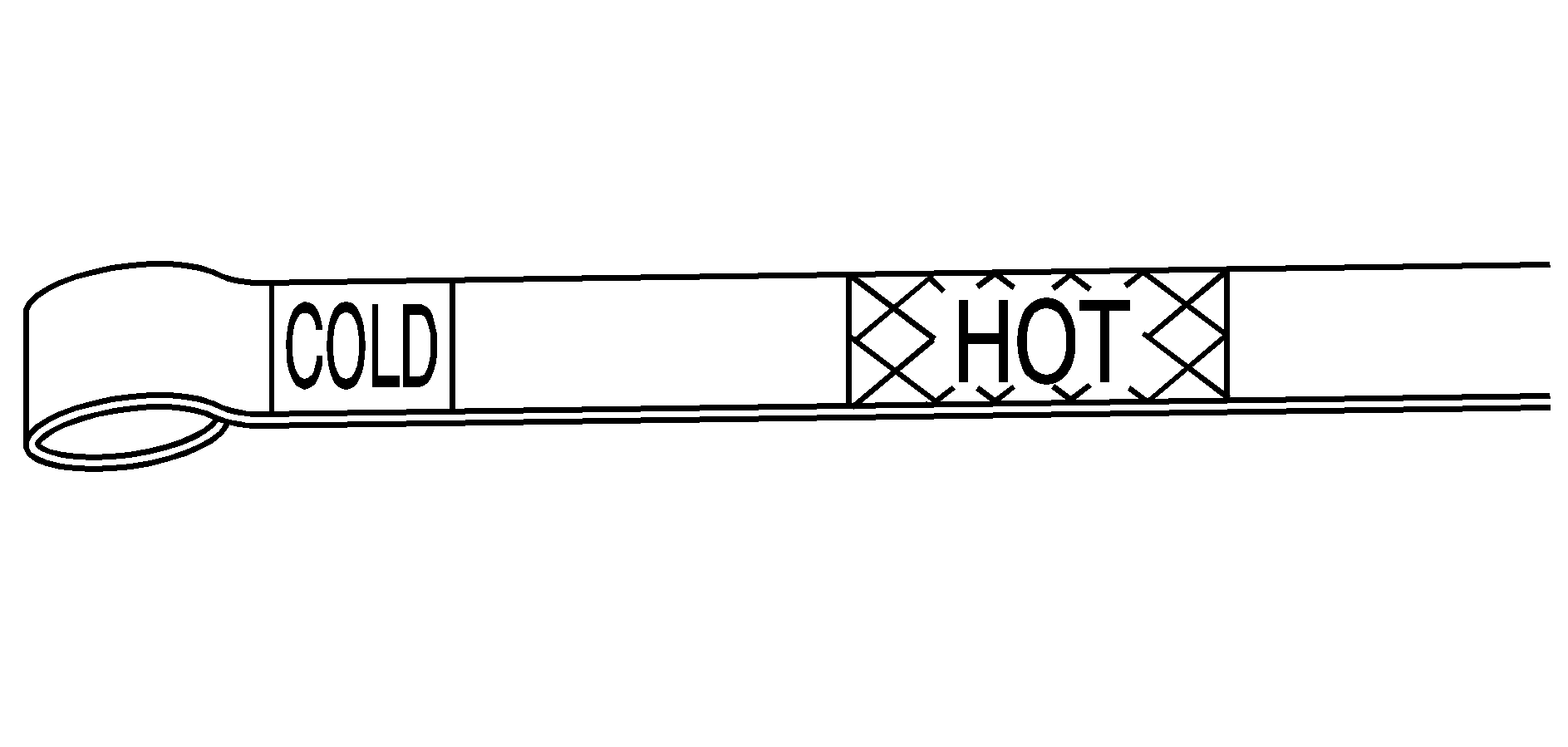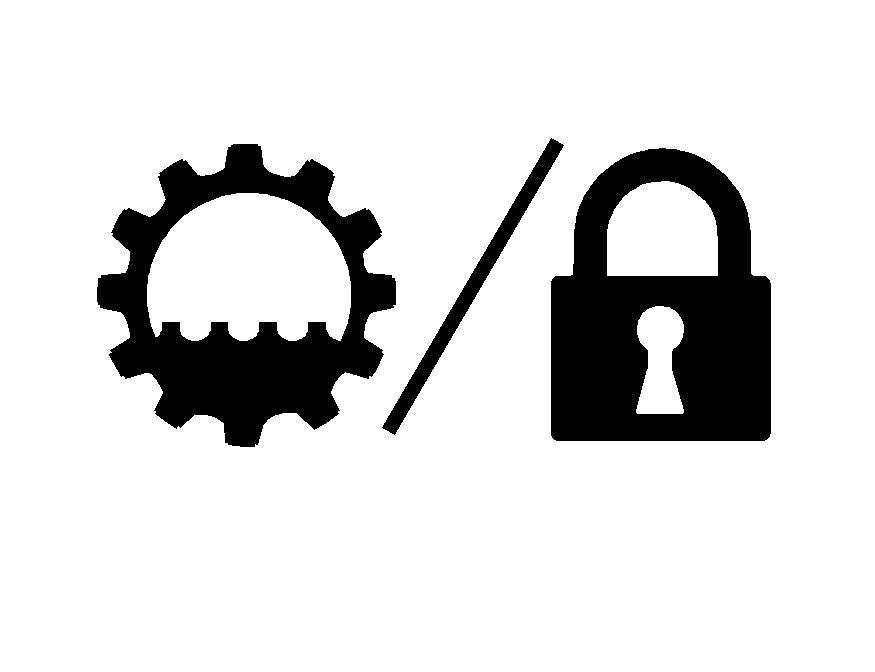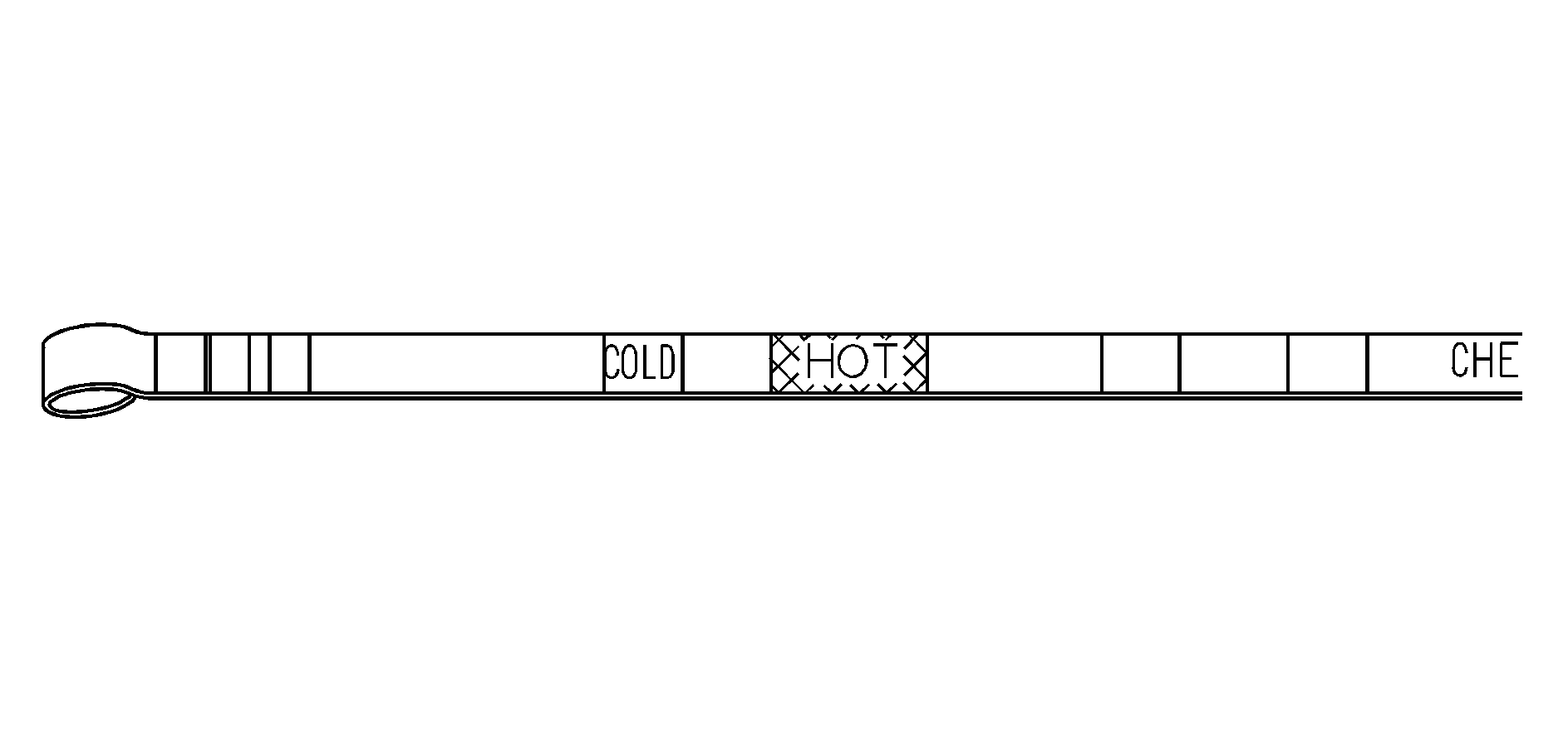For more information, see "Automatic Transmission Fluid" in the owner manual.
Checking the Fluid Level

The vehicle's automatic transmission dipstick looks like this. For more information on location, see Engine Compartment Overview.
When to Check and Change Automatic Transmission Fluid
It is usually not necessary to check the transmission fluid level. The only reason for fluid loss is a transmission leak or overheating the transmission. If you suspect a small leak, then use the following checking procedures to check the fluid level. However, if there is a large leak, then it may be necessary to have the vehicle towed to a dealer/retailer service department and have it repaired before driving the vehicle further.
Notice: Use of the incorrect automatic transmission fluid may damage the vehicle, and the damages may not be covered by the vehicle's warranty. Always use the automatic transmission fluid listed in Recommended Fluids and Lubricants .
Change the fluid and filter at the intervals listed in the Maintenance Schedule. See Scheduled Maintenance . Be sure to use the transmission fluid listed in Recommended Fluids and Lubricants .
How to Check Automatic Transmission Fluid
Notice: Too much or too little fluid can damage your transmission. Too much can mean that some of the fluid could come out and fall on hot engine parts or exhaust system parts, starting a fire. Too little fluid could cause the transmission to overheat. Be sure to get an accurate reading if you check your transmission fluid.
Before checking the fluid level, prepare your vehicle as follows:
- Start the engine and park your vehicle on a level surface. Keep the engine running.
- Apply the parking brake and place the shift lever in PARK (P).
- With your foot on the brake pedal, move the shift lever through each gear range, pausing for about three seconds in each range. Then, move the shift lever back to PARK (P).
- Allow the engine to idle (500 - 800 rpm) for at least one minute. Slowly release the brake pedal.
- Keep the engine running and press the Trip/Fuel button or trip odometer reset stem until TRANS TEMP (Transmission Temperature) displays on the Driver Information Center (DIC).
- Using the TRANS TEMP reading, determine and perform the appropriate check procedure. If the TRANS TEMP reading is not within the required temperature ranges, allow the vehicle to cool, or operate the vehicle until the appropriate transmission fluid temperature is reached.
Cold Check Procedure
Use this procedure only as a reference to determine if the transmission has enough fluid to be operated safely until a hot check procedure can be made. The hot check procedure is the most accurate method to check the fluid level. Perform the hot check procedure at the first opportunity. Use this cold check procedure to check fluid level when the transmission temperature is between 80°F and 90°F (27°C and 32°C).
- Locate the transmission dipstick at the rear of the engine compartment, on the passenger’s side of the vehicle.
- Flip the handle up, and then pull out the dipstick and wipe it with a clean rag or paper towel.
- Install the dipstick by pushing it back in all the way, wait three seconds, and then pull it back out again.
- Check both sides of the dipstick, and read the lower level. Repeat the check procedure to verify the reading.
- If the fluid level is below the COLD check band, add only enough fluid as necessary to bring the level into the COLD band. It does not take much fluid, generally less than one pint (0.5L). Do not overfill.
- Perform a hot check at the first opportunity after the transmission reaches a normal operating temperature between 160°F to 200°F (71°C to 93°C).
- If the fluid level is in the acceptable range, push the dipstick back in all the way, then flip the handle down to lock the dipstick in place.

The dipstick handle has this graphic. See Engine Compartment Overview for more information.

Hot Check Procedure
Use this procedure to check the transmission fluid level when the transmission fluid temperature is between 160°F and 200°F (71°C and 93°C).
The hot check is the most accurate method to check the fluid level. The hot check should be performed at the first opportunity in order to verify the cold check. The fluid level rises as fluid temperature increases, so it is important to ensure the transmission temperature is within range.
- Locate the transmission dipstick at the rear of the engine compartment, on the passenger’s side of the vehicle.
- Flip the handle up, and then pull out the dipstick and wipe it with a clean rag or paper towel.
- Install the dipstick by pushing it back in all the way, wait three seconds, and then pull it back out again.
- Check both sides of the dipstick, and read the lower level. Repeat the check procedure to verify the reading.
- Safe operating level is within the HOT crosshatch band on the dipstick. If the fluid level is not within the HOT band, and the transmission temperature is between 160°F and 200°F (71°C and 93°C), add or drain fluid as necessary to bring the level into the HOT band. If the fluid level is low, add only enough fluid to bring the level into the HOT band. It does not take much fluid, generally less than one pint (0.5L). Do not overfill.
- If the fluid level is in the acceptable range, push the dipstick back in all the way, then flip the handle down to lock the dipstick in place.

The dipstick handle has this graphic. See Engine Compartment Overview for more information.

Consistency of Readings
Always check the fluid level at least twice using the procedures described. Consistency (repeatable readings) is important to maintaining proper fluid level. If fluid is added, it may take 15 minutes or longer to obtain an accurate reading because of residual fluid draining down the dipstick tube. If inconsistent readings persist, check the transmission breather to be sure it is clean and not clogged. If readings are still inconsistent, contact your dealer/retailer.
When to Check and Change (Pickup Models)
A good time to check your automatic transmission fluid level is when the engine oil is changed.
Change both the fluid and filter every 25,000 miles (41 500 km) if the vehicle is mainly driven under one or more of these conditions:
| • | In heavy city traffic where the outside temperature regularly reaches 90°F (32°C) or higher. |
| • | In hilly or mountainous terrain. |
| • | When doing frequent trailer towing. |
| • | Uses such as found in taxi, police or delivery service. |
If you do not use your vehicle under any of these conditions, change the fluid and filter every 50,000 miles (83 000 km).
How to Check
Because this operation can be a little difficult, you may choose to have this done at the dealership service department.
If you do it yourself, be sure to follow all the instructions here, or you could get a false reading on the dipstick.
Notice: Too much or too little fluid can damage your transmission. Too much can mean that some of the fluid could come out and fall on hot engine parts or exhaust system parts, starting a fire. Too little fluid could cause the transmission to overheat. Be sure to get an accurate reading if you check your transmission fluid.
Wait at least 30 minutes before checking the transmission fluid level if you have been driving:
| • | When outside temperatures are above 90°F (32°C). |
| • | At high speed for quite a while. |
| • | In heavy traffic -- especially in hot weather. |
| • | While pulling a trailer. |
Checking the Fluid Level
Prepare your vehicle as follows:
| • | Park your vehicle on a level place. Keep the engine running. |
| • | With the parking brake applied, place the shift lever in P (Park). |
| • | With your foot on the brake pedal, run the engine for at least one minute and shift to D (Drive). Then shift to N (Neutral) and then R (Reverse) to fill the hydraulic system. Then, put the shift lever in P (Park). |
| • | Allow the engine to run at idle (500 - 800 rpm). Slowly release the brake pedal. |
Then, without shutting off the engine, follow these steps:
Cold Check Procedure
The purpose of the cold check is to determine if the transmission has enough fluid to be operated safely until a hot check can be made. The fluid level rises as fluid temperature increases. DO NOT fill above the COLD CHECK band if the transmission fluid is below normal operating temperatures.
- Pull out the dipstick and wipe it with a clean rag or paper towel. The transmission dipstick is located near the center of the engine compartment. See Engine Compartment Overview for more information on location.
- Push it back in all the way, wait three seconds and then pull it back out again.
- Check the fluid level reading. Repeat the check procedure to verify the reading.
- If the fluid level is within the COLD CHECK band, the transmission may be operated until the fluid is hot enough to perform a hot check. If the fluid level is not within the COLD CHECK band, add or drain fluid as necessary to bring the level into the middle of the COLD CHECK band.
- Perform a hot check at the first opportunity after the normal operating temperature of 160°F (71°C) to 200°F (93°C) is reached.
- If the fluid level is in the acceptable range, push the dipstick back in all the way.
Hot Check Procedure
The fluid must be hot to ensure an accurate check. The fluid level rises as temperature increases.
- Operate the transmission in D (Drive) until the normal operating temperature of 160°F (71°C) to 200°F (93°C) is reached.
- Pull out the dipstick and wipe it with a clean rag or paper towel.
- Push it back in all the way, wait three seconds and then pull it back out again. Repeat the check procedure to verify the reading.
- Safe operating level is within the HOT RUN band on the dipstick. The width of the HOT RUN band represents approximately 1.06 quart (1.0 liter) of fluid at normal operating temperature.
- If the fluid level is not within the HOT RUN band, add or drain fluid as necessary to bring the fluid level to within the HOT RUN band.
- If the fluid level is in the acceptable range, push the dipstick back in all the way.
Consistency of Readings
Always check the fluid level at least twice using the procedures described previously. Consistency is important to maintaining proper fluid level. If inconsistent readings persist, check the transmission breather to be sure it is clean and unclogged. If readings are still inconsistent, contact your dealer.
How to Add Fluid
In cold operation, Allison recommends using Synthetic Transmission Fluid approved to Allison Transmission specification TES-295 in areas where the minimum ambient temperatures are below -40°C (-40°F).
Refer to the Maintenance Schedule to determine what kind of transmission fluid to use. See Recommended Fluids and Lubricants.
Add fluid only after checking the transmission fluid while it is hot. A cold check is used only as a reference. If the fluid level is low, add only enough of the proper fluid to bring the level up to the HOT area for a hot check. It doesn't take much fluid, generally less than one pint (0.5 L). Don't overfill.
Notice: Use of the incorrect automatic transmission fluid may damage your vehicle, and the damages may not be covered by your warranty. Always use the automatic transmission fluid listed in Recommended Fluids and Lubricants .
| • | After adding fluid, recheck the fluid level as described under "How to Check." |
| • | When the correct fluid level is obtained, push the dipstick back in all the way. |
When to Check and Change (Van Models)
A good time to check your automatic transmission fluid level is when the engine oil is changed.
Change the fluid and filter at the intervals listed in "Additional Required Services". See Additional Required Services.
And be sure to use the transmission fluid listed in "Recommended Fluids and Lubricants". See Recommended Fluids and Lubricants for more information.
How to Check
Because this operation can be a little difficult, you may choose to have this done at the dealership service department.
If you do it yourself, be sure to follow all the instructions here, or you could get a false reading on the dipstick.
Notice: Too much or too little fluid can damage your transmission. Too much can mean that some of the fluid could come out and fall on hot engine parts or exhaust system parts, starting a fire. Too little fluid could cause the transmission to overheat. Be sure to get an accurate reading if you check your transmission fluid.
Wait at least 30 minutes before checking the transmission fluid level if you have been driving:
| • | When outside temperatures are above 90°F (32° C). |
| • | At high speed for quite a while. |
| • | In heavy traffic -- especially in hot weather. |
| • | While pulling a trailer. |
To get the right reading, the fluid should be at normal operating temperature, which is 180°F to 200°F (82°C to 93°C). Get the vehicle warmed up by driving about 15 miles (24 km) when outside temperatures are above 50°F (10°C). If it is colder than 50°F (10°C), drive the vehicle until the engine temperature gage moves and then remains steady for 10 minutes.
A cold check can be made after the vehicle has been sitting for eight hours or more with the engine off, but this is used only as a reference. Let the engine run at idle for five minutes if outside temperatures are 50°F (10°C) or more. If it is colder than 50°F (10°C), you may have to idle the engine longer. Should the fluid level be low during this cold check, you must check the fluid hot before adding fluid. Checking the fluid hot will give you a more accurate reading of the fluid level.
Checking the Fluid Level
Prepare your vehicle as follows:
| • | Park your vehicle on a level place. Keep the engine running. |
| • | With the parking brake applied, place the shift lever in P (Park). |
| • | With your foot on the brake pedal, move the shift lever through each gear range, pausing for about three seconds in each range. Then, position the shift lever in P (Park). |
| • | Let the engine run at idle for three minutes or more. |
Then, without shutting off the engine, follow these steps:

The transmission dipstick is located near the center of the engine compartment and will be labeled with the graphic shown.
See Engine Compartment Overview for more information on location.
- Flip the handle up and then pull out the dipstick and wipe it with a clean rag or paper towel.
- Push it back in all the way, wait three seconds and then pull it back out again.
- Check both sides of the dipstick, and read the lower level. The fluid level must be in the COLD area for a cold check or in the HOT or cross-hatched area for a hot check. Be sure to keep the dipstick pointed down to get an accurate reading.
- If the fluid level is in the acceptable range, push the dipstick in all the way, then flip the handle down to lock the dipstick in place.

How to Add Fluid
Refer to the Maintenance Schedule to determine what kind of transmission fluid to use. See Recommended Fluids and Lubricants.
Using a funnel, add fluid down the transmission dipstick tube only after checking the transmission fluid while it is hot. A cold check is used only as a reference. If the fluid level is low, add only enough of the proper fluid to bring the level up to the HOT area for a hot check. It does not take much fluid, generally less than one pint (0.5L). Do not overfill.
Notice: Use of the incorrect automatic transmission fluid may damage your vehicle, and the damages may not be covered by your warranty. Always use the automatic transmission fluid listed in Recommended Fluids and Lubricants .
| • | After adding fluid, recheck the fluid level as described under "How to Check" earlier in this section. |
| • | When the correct fluid level is obtained, push the dipstick back in all the way. Then flip the handle down to lock the dipstick in place. |
